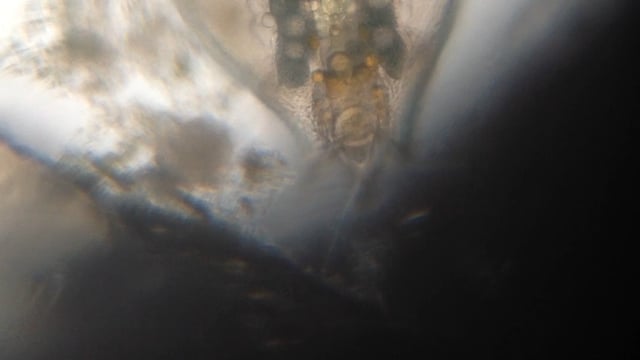Significant Biology learning
 May 29, 2016 • 1:27 PM UTC
May 29, 2016 • 1:27 PM UTC Unknown Location
Unknown Location 140x Magnification
140x Magnification Microorganisms
Microorganisms
Cristina
Learn about the author...
19posts
52comments
1locations


As a Biology teacher, I am aware of how essential it is to find new methods and strategies in order to motivate students. I firmly believe this is the most important clue to improve educational systems achievements. Foldscope illustrates this statement by demonstrating its usage leads to real and significant learning. Here is an example:
A few days ago I saw some water fleas in my everlasting fresh water sample. Just imagine it might have been observed by a student anywhere. He or she would have seen this:
A few days ago I saw some water fleas in my everlasting fresh water sample. Just imagine it might have been observed by a student anywhere. He or she would have seen this:

Wow! Wow! Wow! This is an experience not everyone is lucky enough to undergo…. So what is next should flow spontaneously. The student might observe, even without knowing Taxonomy at all, it has jointed appendages made by diverse segments that can move independently……… More than six legs, biramous antennae (with some guideness he/she will find two pairs), … And so many more features that he or she surely will be learning with ease and, futhermore, with joy. Later, they will associate those characteristics with scientific names (Arthropoda, Crustaceans, … ).
But this is only the beggining ……. just go on reading 😊.
Watching (no doubt, with complete astonishment) the water flea move, they will understand the second pair of antennae are responsible of that motion, and that a bivalve caparace (that can open slightly and show the internal appendages) encloses the body with exception of the head.
But this is only the beggining ……. just go on reading 😊.
Watching (no doubt, with complete astonishment) the water flea move, they will understand the second pair of antennae are responsible of that motion, and that a bivalve caparace (that can open slightly and show the internal appendages) encloses the body with exception of the head.
If molts are found, actually quite easy to encounter, as the one in the next image, ideas of empty and complete exoskeletons would link with the need of removing the old ones to accomplish growth.

Some days later, maybe, a now brownish water flea might call their atention. Some strange black dots are present dorsally.
If they are patient enough to observe a pause in this Crustacean’s jerky movement, the mystery will go on.



As you have witnessed too, they might suddenly see baby water fleas that were not observable a few minutes ago. What has happened? Two adults and, all at once, some small ones fussing around. Any ideas?
And what is more, what is this individual trying to do. Watch, please.
And what is more, what is this individual trying to do. Watch, please.
To their surprise and amazement, they will be able to watch a female water flea revealing the answer:
In conclusion, I have tried to imagine what could have happened if, instead of working Arthropods (Insects, Miriapods, Aracnids, ……..Crustaceans) using books, anatomical puzzles, dissecting crabs or similar and using a stereoscope microscope for a more detailed observation, etc. , a teenager had used a foldscope. It is obvious that Nature blossoms by means of this paper microscope, and passion for Biology and all related subjects is then settled.
Our lucky student now knows what a cladoceran is; that, although books say Crustaceans develop undergoing a larval phase (Nauplius), this group doesn’t. They can understand (if they have only females) that parthenogenesis is another way of reproduction, that makes clones of the mother. Even more, by watching the greenish gut in adults and not seeing that colour in the ones that have been born, they might conclude they feed on phytoplankton.
Our lucky student now knows what a cladoceran is; that, although books say Crustaceans develop undergoing a larval phase (Nauplius), this group doesn’t. They can understand (if they have only females) that parthenogenesis is another way of reproduction, that makes clones of the mother. Even more, by watching the greenish gut in adults and not seeing that colour in the ones that have been born, they might conclude they feed on phytoplankton.

Many more facts and features might be written in this post, but I do not want to make it longer. Next image shows something I usually ask my students to do when we have finished some contents that need visual understanding.


Thanks for reading.
Cristina Bosch
Cristina Bosch
Sign in to commentNobody has commented yet... Share your thoughts with the author and start the discussion!

 0 Applause
0 Applause 0 Comments
0 Comments














